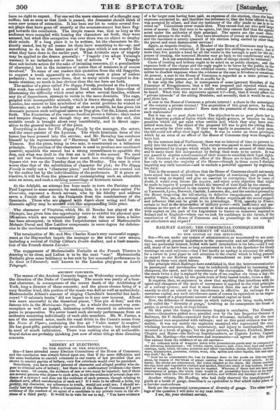RAILWAY GAUGE: THE COMMERCIAL CONSEQUENCES OF DIVERSITY OF GAUGE.
TO THE EDITOR OF THE SPECTATOR.
SIR—We are under our system of administration so accustomed to see ques- tions, merely of general importance to the community and not affecting greatly any one particular interest, trifled with until interference is too lete,—and I may add, many of us have been so long accustomed to look to the Spectator for timely warnings on such subjects,—that I feel hardly an apology is necessary for asking for a corner in your paper to call attention to the course which is bemg pursued in regard to our Railway system. ' My encroachment on your space will be limited to three very short letters. The principle which Railways have established is, that the intercommunication in passengers and merchandise may be indefinitely multiplied by inereasing.the cheapness, the speed, and the convenience of the conveyance. On this principle, the coach twice a day is replaced by the train of ten coaches six times a day; the weekly waggon or barge, by the goods-train of forty loaded trucks, twice a day.
It requires, then, no argument to show that anything that interferes with the speed and cheapness of the mode of conveyance is opposed to the vital principles of a railway system; and that it must detract from the use of the invention exactly to such an extent as the interference is effective. As railways fix en enormous capital, any such interference most of course be equivalent to an unpro- ductive waste of a proportional amount of national capital so fixed. Now, the difference of dimensions on which railways are being made, techni- cally called the " diversity of gauge," involving as its consequence the break of gauge, is precisely such an impediment.
On this point the Gauge Commission inquiry is conclusive.. The Commis- sioners—themselves picked men, presided over by the late Inspector-General of Railways, Sir F. Smith—examined forty-five witnesses, including all the most experienced men acquainted with railways; and on this point evidence was irre- sistible. It was not merely the engineers examined who represented the over- whelming inconvenience, delay, uncertainty, and injury to merchandise, which occurred at a break of gauge; but the great carriers, as Messrs. Pickford, Messrs. Chaplin and Home—the Railway Supenuteridents, as Captain Lewes, Captain Hnish, Mr. Harding—the coalowners and ironmasters—all agreed on this pout One extract from the evidence of an old carrier- " An ordinary train of waggons laden with promiscuous goods may be composed Of the following descriptions ; viz. bricks, slates, manure, salt. coke, iron, lead and metal• castings, bark, hides, oll-cake, potatoes and other vegetables, cheese, furniture, earthen- ware, drysalteries, groceries, cotton, wool, oils, spirits and other liquids, fish and eggs, ripe fruit," &c. &c. " Now let us contemplate the loss by damage done to the goods on this one train alone, by reason of the break of gauge causing the removal of every article. In the hurry, the bricks are miscounted, the slates chipped at the edges, the cheese cracked, the ripe fruit and vegetables crushed and spoiled, fizruiture more or less broken, the salt short of weight, and the fish too late for market. Whereas, if there had not been iloY interruption of gauge, the whole train would in all probability have been at Its deed' nation long before the transfer of the last article, and without any damage or delay." Another witness, Mr. Harding, who had daily observed the transhipment of goods at a break of gauge, describes it as equivalent to that which takes place al a barrier customhouse.
Stich-are the commereial consequences of diversity of gauge. The other beer- ings of the question I will defer to my next letter. W. I am, Sir, your obedient servant,


























 Previous page
Previous page